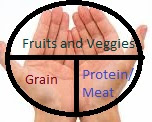Amanda's Healthy Eating Recommendations:
- Hold out your hands with palms up and little fingers touching, this is your plate
- One palm represents a grain serving
- Grain or starchy vegetable such as a small baked potato
- The other palm represents a protein or meat serving
- Lean meats are recommended most of the time (chicken, pork, fish, turkey and beef) cooked to maximize flavor an minimize added fat broiled or grilled over fried
- Your fingers represent fruits and vegetables
- These are the non-starchy vegetables (not potatoes or corn)
- Fresh, canned or frozen without added sauces, syrups and rinsed if they're canned vegetables
- Add a side of dairy (yogurt, milk or cheese)
This healthy eating recommendation is a simplified version of MyPlate but also takes into account the size of the person and is a fun demonstration for kids. If after eating the amount of food corresponding to the size of your hands (or plate), you simply have more fruits and vegetables, illustrated to kids by fanning out their hands and wiggling their fingers.
The plate method is a goal for healthy eating and may not be practical as a first step. By setting one small goal at a time and achieving that, adjusting to a more healthful intake can seem more achievable.
This guide serves as a general approach to healthy eating. If you would like more personalized nutrition recommendations please find a Registered Dietitian or RD/N.
Have you heard that a glass of red wine is comparable to one hour at the gym? Is there any truth to that?
The compound in wine (red wine specifically) that is at the root of this claim is Resveratrol (REZ-VER-A-TR-ALL) and is actually found in other berries, grapes and even peanuts(1). Resveratrol is a type of compound called a polyphenol a type of antioxidant. The notion that red wine has cardiovascular benefits has yet to be proven in large randomized controlled trials. However, red wine has other polyphenollic compounds that have been shown to have health benefits such as anti-inflammatory and anti-atherogenic properties. Sadly, red wine does not have a large concentration of these polyphenols (1).
While red wine may not have all the advantages of an hour of cardio, it has been shown to be one of the more healthful alcoholic beverage choices.
Red Wine Myths:
1. Red wine can prevent cancer
2. All wine tastes better with age
3. The more expensive, the better the wine
In conclusion, drinking one glass of wine on occasion can have some health benefits, drinking should be done in moderation (one drink for women and two for men) and never while pregnant. Written while enjoying a glass of my favorite red.
References:
1. Resveratrol. Linus Pauling Institute. Oregon State University. 2015.
Image
I began my in-patient clinical rotation in early January, hence the lack of posts since then. My clinical site is about 1 hour away from where I live, which makes for early morning. Acute care is the longest rotation, 8 weeks, two of which are staff-relief. The first week was spent with the clinical nutrition manager (CNM) and was focused on building a foundation for the remaining weeks.
Week 1:
Nutrition focused physical exam
Thorough chart reading
Obtaining subjective history, from patient, family and or long term care facility
Assessment chart note
Weeks 2 & 3:
Diabetes and renal with assessments and rescreens of patients on the medical floor
Weeks 4 & 5:
Oncology and surgical assessments and rescreens with an intro to nutrition support
Week 6 (this week):
ICU nutrition support during critical care
Each week the CNM and I review two notes and discuss any and all aspects of the patient and why I chose the given diagnosis. Each day includes discussions of the metabolic state of patients with medication interactions and altered needs due to disease(s).
I am thankful that my acute care rotation is later in my internship, as I have had experience working with other members of the medical team and patient interactions prior.
So far the most interesting highlight has been working with the speech therapist. She let me observe a video swallow study and explained each component. In relation to another patient she explained the difference in a swallow study of a patient post-stroke compared to a patient who has a neuro-degenerative disease (such as Parkinson's). It was important to learn this as the diet order and nutritional concerns for these two diagnoses vary.

